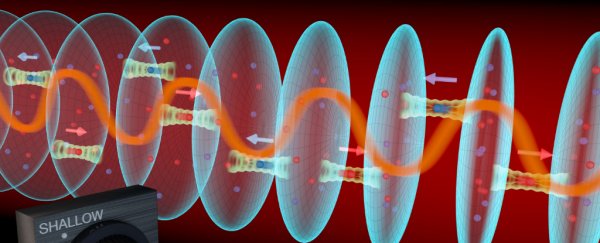Researchers have managed to mimic one of physics' most sought-after phenomena - a strange 'synthetic' magnetic state that has previously only been seen in hard-to-study solid materials.
This means the team can finally use an experimental model to test the behaviour, known as spin-orbit coupling, which could play a big role in developing the future of ultra-fast 'spintronic' devices and quantum computers.
The team was able to model this synthetic magnetic state using an atomic clock, which are usually used to keep more precise time thanks to lasers isolating the atoms and using their electrons to keep a beat. In this case, the jumping of confined atoms due to an effect called quantum tunnelling made a good model for the spin-orbit interaction seen in electrons in crystalline solids.
Crystalline solids are a type of 'true' solid, which have their atoms or molecules all neatly arranged in an ordered, symmetrical, and repeating pattern. Minerals with a cubic structure, such as diamonds, are crystalline solids, and so are metals like gold.
On the macro scale, we have a pretty good understanding of how these materials work, but on the quantum scale - when you get down to looking at individual atoms as bunches of particles - they display some pretty weird properties.
One of these is a type of strange behaviour known as spin-orbit coupling, where individual electrons behave as if they possess magnetic properties. If scientists can understand how this works and how to tap into that ability, it could help them create better quantum materials for super-fast computers and electronics.
Spin-orbit coupling is where the spin of an electron (the direction of its moment) is locked into its orbit around the nucleus, and creates all kind of weird and useful effects, such as a weak magnetic force.
This phenomenon one of the most important features in topological materials - strange materials that conduct electricity on the surface but act as insulates on the inside, and were honoured in this year's Nobel Prize.
Topological materials are so fascinating for scientists because they could be used to create 'spintronic' devices that are based on the spin of electrons rather than usual electrical charge - and they could also create quantum computers of the future.
But achieving spin-orbit coupling in solid materials is incredibly challenging. So physicists from the Joint Institute of Laboratory Astrophysics (JILA) in Colorado did the same thing with their atomic clock instead.
To do this, they locked a strontium atom's spin - which is like a tiny internal bar magnet - with the atom's external motion through the optical lattice.
After doing this with thousands of these strontium atoms within the clock, they were able to create a synthetic magnetic field that lasted for 160 seconds - plenty of time to study some of the signatures of spin-orbit coupling in detail, such as watching the atoms rippling through the lattice.
"The atoms move from site to site on the lattice (a crystal of light created by the laser), and that's a lot like the physics you get in a solid like a metal or other material where electrons move around in a periodic crystalline structure," said one of the researchers, Shimon Kolkowitz.
There's still a lot to learn about how spin-orbit coupling works, but the team hopes that now they have a way to easily model the phenomenon, they might have a better chance of unlocking its secrets.
They're now planning to make a 3D version of the atomic clock to get more insight into what's going on.
"Spin-orbit coupling is useful for studying novel quantum materials," said lead researcher Jun Ye.
"By using our atomic clock for quantum simulation, we hope to stimulate new insights and shed new light on emerging behaviours of topological systems that are useful for robust quantum information processing and spintronics."
The more we understand about these weird quantum behaviours, the more we understand about the rest of the world, so we can't wait to learn more.
The research has been published in Nature.
